CFA franc
The CFA franc (in French: franc CFA [fʁɑ̃ seɛfɑ], originally Franc of the French Colonies in Africa, recently Franc of the Financial Community of Africa, or colloquially franc) is the name of two currencies, the West African CFA franc, used in eight West African countries, and the Central African CFA franc, used in six Central African countries. Both currencies are guaranteed by the French treasury. Although separate, the two CFA franc currencies have always been at parity and are effectively interchangeable. The ISO currency codes are XAF for the Central African CFA franc and XOF for the West African CFA franc. On 22 December 2019, it was announced that the West African currency would be replaced by an independent currency to be called Eco.[1]

West African CFA franc (XOF)
Central African CFA franc (XAF)
Both CFA francs have a fixed exchange rate to the euro: 100 CFA francs = 1 former French (nouveau) franc = 0.152449 euro; or 1 € = 6.55957 FRF = 655.957 CFA francs exactly.
Usage
CFA francs are used in fourteen countries: twelve nations formerly ruled by France in West and Central Africa (excluding Guinea and Mauritania, which withdrew), plus Guinea-Bissau (a former Portuguese colony), and Equatorial Guinea (a former Spanish colony). These fourteen countries have a combined population of 147.5 million people (as of 2013),[2] and a combined GDP of US$166.6 billion (as of 2012).[3] The ISO currency codes are XAF for the Central African CFA franc and XOF for the West African CFA franc.
Evaluation
The currency has been criticized for making economic planning for the developing countries of French West Africa all but impossible since the CFA's value is pegged to the euro (whose monetary policy is set by the European Central Bank).[4] Others disagree and argue that the CFA "helps stabilize the national currencies of Franc Zone member-countries and greatly facilitates the flow of exports and imports between France and the member-countries".[5] The European Union's own assessment of the CFA's link to the euro, carried out in 2008, noted that "benefits from economic integration within each of the two monetary unions of the CFA franc zone, and even more so between them, remained remarkably low" but that "the peg to the French franc and, since 1999, to the euro as exchange rate anchor is usually found to have had favourable effects in the region in terms of macroeconomic stability".[6]
Name
Between 1945 and 1958, CFA stood for Colonies françaises d'Afrique ("French colonies of Africa"); then for Communauté française d'Afrique ("French Community of Africa") between 1958 (establishment of the French Fifth Republic) and the independence of these African countries at the beginning of the 1960s. Since independence, CFA is taken to mean Communauté Financière Africaine (African Financial Community),[7] but in actual use, the term can have two meanings (see Institutions below).
History
Creation
The CFA franc was created on 26 December 1945, along with the CFP franc. The reason for their creation was the weakness of the French franc immediately after World War II. When France ratified the Bretton Woods Agreement in December 1945, the French franc was devalued in order to set a fixed exchange rate with the US dollar. New currencies were created in the French colonies to spare them the strong devaluation, thereby facilitating imports from France. French officials presented the decision as an act of generosity. René Pleven, the French minister of finance, was quoted as saying -
In a show of her generosity and selflessness, metropolitan France, wishing not to impose on her far-away daughters the consequences of her own poverty, is setting different exchange rates for their currency.
Exchange rate
The CFA franc was created with a fixed exchange rate versus the French franc. This exchange rate was changed only twice: in 1948 and in 1994.
Exchange rate:
- 26 December 1945 to 16 October 1948 – 1 CFA franc = 1.70 FRF (FRF = French franc). This 0.70 FRF premium is the consequence of the creation of the CFA franc, which spared the French African colonies the devaluation of December 1945 (before December 1945, 1 local franc in these colonies was worth 1 French franc).
- 17 October 1948 to 31 December 1959 – 1 CFA franc = 2.00 FRF (the CFA franc had followed the French franc's devaluation versus the US dollar in January 1948, but on 18 October 1948, the French franc devalued again and this time the CFA franc was revalued against the French franc to offset almost all of this new devaluation of the French franc; after October 1948, the CFA was never revalued again versus the French franc and followed all the successive devaluations of the French franc)
- 1 January 1960 to 11 January 1994 – 1 CFA franc = 0.02 FRF (1 January 1960: the French franc redenominated, with 100 "old" francs becoming 1 "new" franc)
- 12 January 1994 to 31 December 1998 – 1 CFA franc = 0.01 FRF (sharp devaluation of the CFA franc to help African exports)
- 1 January 1999 onwards – 100 CFA franc = 0.152449 euro or 1 euro = 655.957 CFA franc. (1 January 1999: euro replaced FRF at the rate of 6.55957 FRF for 1 euro)
The 1960 and 1999 events were merely changes in the currency in use in France: the relative value of the CFA franc versus the French franc/euro changed only in 1948 and 1994.
The value of the CFA franc has been widely criticized as being too high, which many economists believe favours the urban elite of the African countries, who can buy imported manufactured goods cheaply at the expense of farmers who cannot easily export agricultural products. The devaluation of 1994 was an attempt to reduce these imbalances.
Changes in countries using the franc
Over time, the number of countries and territories using the CFA franc has changed as some countries began introducing their own separate currencies. A couple of nations in West Africa have also chosen to adopt the CFA franc since its introduction, despite the fact that they were never French colonies.
- 1960: Guinea leaves and begins issuing Guinean francs
- 1962: Mali leaves and begins issuing Malian francs
- 1973: Madagascar leaves (in 1972, according to another source) and begins issuing its own francs, the Malagasy franc, which ran concurrently with the Malagasy ariary (1 ariary = 5 Malagasy francs)
- 1973: Mauritania leaves, replacing the franc with the Mauritanian ouguiya (1 ouguiya = 5 CFA francs)
- 1974: Saint-Pierre and Miquelon leaves for French franc, which changed later to the Euro
- 1975: Réunion leaves for French franc,[8] which changed later to the Euro
- 1976: Mayotte leaves for French franc,[9] which changed later to the Euro
- 1984: Mali rejoins (1 CFA franc = 2 Malian francs)
- 1985: Equatorial Guinea joins (1 franc = 4 bipkwele)
- 1997: Guinea-Bissau joins (1 franc = 65 pesos)
European Monetary Union
In 1998, in anticipation of Economic and Monetary Union of the European Union, the Council of the European Union addressed the monetary agreements France had with the CFA Zone and Comoros and ruled that:
- The agreements are unlikely to have any material effect on the monetary and exchange rate policy of the Eurozone
- In their present forms and states of implementation, the agreements are unlikely to present any obstacle to a smooth functioning of economic and monetary union
- Nothing in the agreements can be construed as implying an obligation for the European Central Bank (ECB) or any national central bank to support the convertibility of the CFA and Comorian francs
- Modifications to the existing agreements will not lead to any obligations for the European Central or any national central bank
- The French Treasury will guarantee the free convertibility at a fixed parity between the euro and the CFA and Comorian francs
- The competent French authorities shall keep the European Commission, the European Central Bank and the Economic and Financial Committee informed about the implementation of the agreements and inform the Committee prior to changes of the parity between the euro and the CFA and Comorian francs
- Any change to the nature or scope of the agreements would require Council approval on the basis of a Commission recommendation and ECB consultation
Reforms
In 2019, a reform of the West African CFA franc was initiated. In May 2020, the French National Assembly agreed to end the French engagement in the West African CFA franc. The countries using the currency will no longer have to deposit half of their foreign exchange reserves with the French Treasury. The West African CFA franc is expected to be renamed to the "Eco" in the near future.[10]
Institutions
There are two different currencies called the CFA franc: the West African CFA franc (ISO 4217 currency code XOF), and the Central Africa CFA franc (ISO 4217 currency code XAF). They are distinguished in French by the meaning of the abbreviation CFA. These two CFA francs have the same exchange rate with the euro (1 euro = 655.957 XOF = 655.957 XAF), and they are both guaranteed by the French treasury (Trésor public), but the West African CFA franc cannot be used in Central African countries, and the Central Africa CFA franc cannot be used in West African countries.
West African
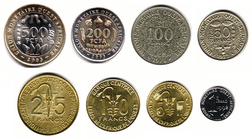
The West African CFA franc (XOF) is known in French as the Franc CFA, where CFA stands for Communauté financière d'Afrique ("Financial Community of Africa") or Communauté Financière Africaine ("African Financial Community").[11] It is issued by the BCEAO (Banque Centrale des États de l'Afrique de l'Ouest, i.e., "Central Bank of the West African States"), located in Dakar, Senegal, for the eight countries of the UEMOA (Union Économique et Monétaire Ouest Africaine, i.e., "West African Economic and Monetary Union"):
These eight countries have a combined population of 102.5 million people (as of 2013),[2] and a combined GDP of US$78.4 billion (as of 2012).[3]
Central African
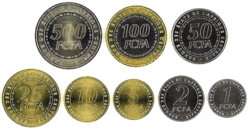
.jpg)
The Central Africa CFA franc (XAF) is known in French as the Franc CFA, where CFA stands for Coopération financière en Afrique centrale ("Financial Cooperation in Central Africa"). It is issued by the BEAC (Banque des États de l'Afrique Centrale, i.e., "Bank of the Central African States"), located in Yaoundé, Cameroon, for the six countries of the CEMAC (Communauté Économique et Monétaire de l'Afrique Centrale, i.e., "Economic and Monetary Community of Central Africa"):
These six countries have a combined population of 45.0 million people (as of 2013),[2] and a combined GDP of US$88.2 billion (as of 2012).[3]
In 1975, Central African CFA banknotes were issued with an obverse unique to each participating country, and common reverse, in a fashion similar to euro coins.
Equatorial Guinea, the only former Spanish colony in the zone, adopted the CFA in 1984.
Criticism
Critics argue that in exchange for the guarantees provided by the French treasury, African countries channel more money to France than they receive in aid. They also argue that they have no say in deciding key monetary policies.[12]
Gallery
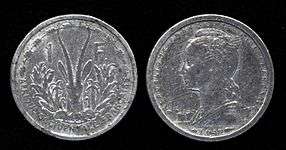 A 1 CFA franc coin.
A 1 CFA franc coin.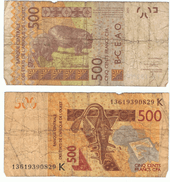 500 West African CFA francs.
500 West African CFA francs.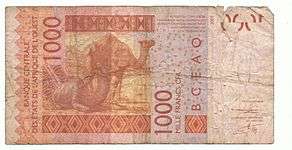 1000 West African CFA francs.
1000 West African CFA francs.
See also
- Comorian franc
- Currencies related to the euro
- CFP franc
- Réunion franc
References
- "West Africa renames CFA franc but keeps it pegged to euro". Reuters. Retrieved 22 December 2019.
- Population Reference Bureau. "2013 World Population Data Sheet" (PDF). Retrieved 1 October 2013.
- World Bank. "Gross domestic product 2012" (PDF). Retrieved 1 October 2013.
- "A strong currency like the CFA franc makes exports from the CFA-franc zone much more costly than they would ordinarily be and as a result economic growth suffers accordingly. Since most of the countries that use the currency are poor, mostly agricultural economies, this has put a stranglehold on their trade and made them overly dependent upon continuing, privileged access to French and, though them, European markets. That this effectively recreates a quasi-colonial trading relationship between France and its former African colonies that benefits France mightily has not been lost on observers. - See more at: http://afkinsider.com/41946/forex-africa-african-euro/#sthash.bAiuUVxB.dpuf", FOREX Africa: The CFA Franc aka The African Euro, By Jeffrey Cavanaugh AFKI Original Published: 12 February 2014, 02:11pm, http://afkinsider.com/41946/forex-africa-african-euro/#sthash.bAiuUVxB.dpuf
- Economic Integration and Development in Africa, Henry Kyambalesa, Mathurin C. Houngnikpo, p. 88
- The role of Euro in Sub Saharan Africa, Economic papers 347, November 2008, http://ec.europa.eu/economy_finance/publications/publication13478_en.pdf
- Encyclopædia Britannica Online, Communauté Financière Africaine franc; accessed 2008.12.05.
- IEDOM/Banque de France - History, Historique des billets Archived 3 July 2013 at the Wayback Machine
- IEDOM/Banque de France Le mot du Directeur de l'agence de Mayotte Archived 27 January 2012 at the Wayback Machine
- "Présentation" (in French). Central Bank of West African States. Retrieved 20 July 2012.
- Konkobo, Lamine (30 August 2017). "Africa's 'colonial currency' debate". Retrieved 21 November 2019.
External links
| Wikimedia Commons has media related to CFA franc. |
- History of the CFA franc
- Franc zone information at Banque de France (in English)
- Franc zone information at Banque de France (in French) (Translate to English: Google, Bing) (in French, but more extensive than the English version)
- Decision of the Council of Europe on 23 November 1998 regarding the CFA and Comorian francs
- "For better or worse: the euro and the CFA franc", Africa Recovery, Department of Public Information, United Nations (April 1999)
Other
- Central Bank of Madagascar
- Passé et Avenir du Franc C.F.A. (in French) (Translate to English: Google, Bing)
- The CFA franc zone and the EMU